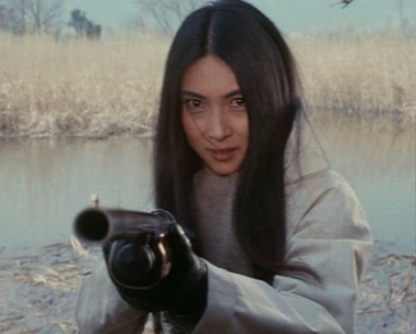
Jeans Blues: No Future (1974) reunites Wandering Ginza Butterfly (1972) stars Tsunehiko Watase and Meiko Kaji for Kaji’s final film at Toei Studios. To helm Jeans Blues: No Future, Toei assigned veteran action film director Sadao Nakajima who is best known in the west for having helmed the Christina Lindberg vehicle The Kyoto Connection (1973). As for the film itself, it is neither as sleazy nor as violent as one would expect.
Jeans Blues: No Future opens with both Jiro (Watase) and Hijiriko (Kaji) reaching a sudden turning point in their lives. Suddenly, like a thunderbolt, ennui gives way to inspiration as both steal from their bosses and hit the road, literally crashing into each other in a blazing car crash. The two full-time losers, thrust together, embark on a life of crime in order to obtain the funds to make good on the debts of Jiro’s sister and escape Japan.
Neither Jiro nor Hijiriko is a professional criminal and much of the film is spent following their misadventures which vary from slapstick to legitimately thrilling as they are pursued by Jiro’s boss and the police. Arthur Penn’s Bonnie & Clyde (1967) is the biggest influence over the proceedings from fashion to character dynamics and tone. But it is a Bonnie & Clyde film set in and made for a contemporary Japan.
Nakajima cross-cuts between the parallel narratives of Jiro and Hijiriko and news headlines of strikes, student demonstrations, Vietnam, and work shortages during the opening credits. This suggests that the ennui giving way to unrest that the central doomed lovers experience is a national problem. Nakajima never references these headlines or the events they describe again in the film but only because there is no need to. The contents of the opening text of the film finds its thematic reprisal in the encounters that Jiro and Hijiriko have with a crooked mechanic, teamsters, and illegal gamblers. Nakajima casts his fatal love birds on a trek from Tokyo to Kyoto that functions as a simultaneous assessment of a cross-section of Japan’s working class.
Jeans Blues: No Future is a film that opens a direct discourse between then current events and the romantic nihilism of the crime film. Bonnie & Clyde was never as audacious as this nor did it allow matinee idol Warren Beatty to be as human as Nakajima’s stars. If Clyde was a quirky bank robber, then Jiro is a bumbling buffoon in response. Penn’s final showdown is executed with stylistic bravura so Nakajima stages the final confrontation in his film as a slow and ugly death devoid of romantic impulses.
As good as Jeans Blues: No Future is, it remains largely unknown beyond fans of Meiko Kaji. Even then fans of the actress tend to dismiss the film because of the actress’ admitted dislike for the picture. But it is a film well worth revisiting or discovering, especially in its new home video edition from Discotek Media.
